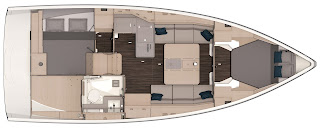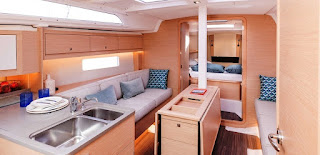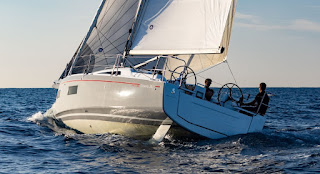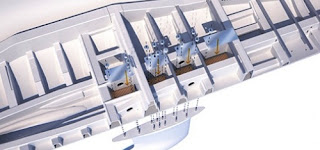Let's start with Bavaria, which has always had nice small cruisers, and now has in that range the Cruiser 34, which in fact is a 32.0 ft boat, certified as Class A (A6 ). It has a very nice hull, designed by Farr, before the mania to increase the hull beam as much as possible (at cost of light wind and upwind performance), for interior volume.
With a beam of 3.42m, a modern cast iron bulbed keel with 2.0m draft and 25.7% B/D, for a 5298kg displacement, it is a relatively heavy boat for its size, as are all in this category. A modern hull, with fine entries and moderate beam, will provide a good sail performance, except upwind with stronger winds and waves, where the small ballast will not be enough to give it a good performance.
It has a modest 17.0 SA/D, (that the narrow hull will maximize), an interior with plenty of cabinets and storage, it is nice, interesting, and comfortable.
In regards to running rigging, it has the possibility of having 6 winches, which allow for easy sailing, even with the standard genoa. It comes standard with a genoa track.
It costs 110 665 euros without VAT at the shipyard and that makes it a very interesting sailboat. It is really a pity the 34 does not have more ballast, but that would increase the price, and I can understand why they have chosen to design the boat like it is, allowing for the less expensive boat in the category, but even so, one of the more rewarding to sail.
Hanse has the 348, that curiously has a Class A certification with less crew (A4). It is a 32.8 ft boat with a 3.50m beam displacing 6560kg, having 2300kg ballast (35%B/D), on an L bulbed cast iron keel, with a 2.0m draft.
 |
| Bavaria 34 |
It is difficult to understand why the Bavaria 34, with a lot less ballast on a similar keel, is certified as A6 while the Hanse is certified as A4. Still, if the technical characteristics are right, the Hanse 348 has a lot more stability than Bavaria, including final stability and a better AVS.
They have different hulls, the one from the Hanse considerably beamier (3.42 to 3.50m) and with larger bow entries, but even so, a nice hull designed by Judel & Vrolijk. All in all the Hanse is a very well-balanced cruiser, offering a bigger interior than the Bavaria 34 on a nicely designed sailboat, that looks bigger than it is. It offers a 4-winch setup, more stiffness (sail power), even though it has a smaller upwind SA/D than the Bavaria 34 (16.2 to 17.0).
 |
Hanse 348 |
Between the two, if the price were the same, I would choose clearly the Hanse 348, but there is a reason for Bavaria being designed the way it is, and that is the price: the Bavaria costs 110 665 euros and the Hanse 137 900 euros. The Bavaria in weak winds and downwind is probably faster than the Hanse, it will give more fun to sail, but will lose clearly in seaworthiness, and with strong winds the Hanse will be much faster upwind, being easier to sail downwind.
Both boats have a good interior with plenty of cabinets, offering the Hanse a bigger forward cabin and a bigger toilet area. Only you know if what Bavaria offers in what regards forward cabin space is enough, taking into consideration that the aft cabin is big. If that is the case the Bavaria, costing considerably less, can make more sense.
 |
Above, SO 349, below, Oceanis 34.1 |
If there is no shortage of money or if the boat is to keep for more years, and if the need for a bigger boat is not previewed in the future, then the Hanse 348 makes more sense. In fact, it will offer much more potential as a cruising boat to sail anywhere, without safety concerns.
Jeanneau has the Sun Odyssey 349, one of the more, if not the most popular cruiser in this segment. It is a 32.7ft boat with 5340kg displacement and a 29.6%B/D with a cast iron L keel, with about 2.0m draft, on a hull with a 3.44 m beam.
 |
Above, Oceanis 34.1, below, Dufour 37 |
The hull is very well designed by Marc Lombard, with narrow entries and almost all the beam pulled aft. It is certified as Class A (A6) and it offers a good sail performance, with an 18.4 SA/D, slightly more that the one of Hanse and it costs 123 500 euros. It is hard to beat what the 349 offers at that price, and it is easier to see why it is a best-seller, but even so, the Bavaria is considerably less expensive and the Hanse offers superior seaworthiness and bigger overall stability, feeling like a bigger boat.
In what regards interior, the SO 349 offers a head as good as the one in the Hanse, a smaller front cabin (due to a small and protruding anchor locker) and an interior that even if it is very nice offers fewer cabinets than the Bavaria or the Hanse. It should also be said that, from the above, it is the only one that offers a true bowsprit, which makes its image more sportive and contributes to a better use of a gennaker or a code 0.
It comes standard with a genoa, but not with a genoa rail. As an option, it can have an efficient but more difficult to use 3d cable system, for controlling genoa shape. It comes without a backstay but it can have one as an option. You should always look at boat prices with the equipment you want because that can turn an apparently cheaper boat into a more expensive one.
 |
Bavaria cruiser 34 |
A very interesting proposition, with a price in between the one of the Bavaria and the Hanse, not as much boat as the Hanse (not the same overall stability or safety stability), but a faster one in most conditions, and also faster than the cheaper Bavaria, even if in light winds, they should be very close, and with Bavaria using a gennaker or a code 0, I doubt very much it will be the case (in light wind).
Beneteau offers the Oceanis 34.1 which is also a 32.7ft boat, also designed by Marc Lombard. It has a very different hull than the Jeanneau, basically because it is much beamier (3.57m to 3.44m). It displaces just a bit more (5470kg to 5340), for a smaller 28.9%B/D, on a similar L cast iron keel with the same draft (2.00).
 |
Above, Hanse 348, below, Jeanneau 349 |
It has a slightly overall bigger stability (more hull form stability) for a slightly worse safety stability and AVS. With a 15.9 SA/D (with the bigger mainsail and the standard self-taking jib) it will be till now the slowest of all considered boats, especially because the smaller SA/D corresponds to a bigger drag. On this one a genoa is really needed and that will give it a 17.9 SA/D, but that implies a more expensive boat, with two additional travelers and a bigger sail (as on the Hanse, for mounting a genoa).
 |
Above Jeanneau 394, below Oceanis 34.1 |
The Hanse and the Oceanis are the beamier boats (3.50 and 3.57), the ones that will sail slower in light wind but also the ones that will heel less while sailing and that means a more comfortable boat for cruising, even if one less rewarding for sailing.
The main difference between the Oceanis and the Hanse, besides the bigger Oceanis beam, is the displacement, the ballast and the B/D, all with influence on the boat stability, being in the overall one, the safety stability or AVS.
The Oceanis will have a bigger hull form stability due to a bigger beam, but that will be more than compensated by the bigger Hanse displacement (6560kg to 5470kg) and for the result, the big B/D difference (35.0% to 28.9%) (with similar keels) will have in the overall stability.
That difference in B/D will have a bigger impact on the safety stability and AVS, which is considerably better on the Hanse.
 |
Dufour 37 |
Like the Jeanneau, the Oceanis has an interior with fewer cabinets than the Hanse or Bavaria (even less than the Jeanneau), and the interior is a lot less nice than the one of the Jeanneau. The front cabin is as bigger as the one of the Hanse and even if the chain locker is bigger than the Jeanneau one, it also protrudes inside the forward cabin. Like the Jeanneau it can have a fixed bowsprit, (but only as an option) and has no backstay, not even an optional one.
Regarding the backstay, that both Hanse and Bavaria have, don't let them convince you that not having a backstay has any advantage, other than allowing for bigger top squared mainsails (that is not the case here, at least standard), and being cheaper. Really sportive or race boats, with square top mainsail have two backstays and use one or another depending on mainsail position.
 |
| Bavaria cruiser 34 |
In fact not having a backstay implies that the spreaders are much more brought aft and that means you can open very little the main while sailing downwind, making it much less effective, it means also that you cannot trim the frontal sail pulling the mast back, or allowing it forward (spreaders less pulled aft) sailing upwind. Obviously, it will also give the rig less stability and less safety.
The Oceanis 34.1 costs 5700 euros more than the Jeanneau (129 200 euros) and I cannot see why. Maybe because the Jeanneau 349 is an older model. But I would say that, if you want a boat that sails with less heel and with a bigger overall stability, you should buy the Hanse 348. It sails better upwind and has a nicer interior with more storage.
 |
Above, Hanse 348, below SO 349 |
The small price difference seems more than justified to me, for a better boat in all aspects, maybe except outside looks, where the Oceanis looks more aggressive and the Hanse more classic.
Dufour has the 32, which is an interesting sailboat, with more SA/D than these ones, but it is only a 30.7ft yacht that does not offer the interior comfort these boats offer. It is a remake of the older 310 (a great boat), with a cheaper finish, a smaller boat that costs 8000 euros more than Bavaria, and only 5000 euros less than the Jeanneau 349. I talked about it here:
https://interestingsailboats.blogspot.com/2022/02/incredible-new-dufour-32.htmlDufour has also the 37, which, incredibly, is only a 32.8ft yacht, the same size as the Hanse 348, for instance. I have seen much misleading information provided by boat builders, but calling a 32.8ft sailboat a 37, beats them all!
The Dufour 37 is a hugely beamy boat, much more than the Oceanis (3.57 to 3.80) that tries to justify the name (37) by a big interior volume, not only due to the beam but because, contrary to the Oceanis, the bow entries are huge. An exercise about how much volume you can put on a given length, signed by Felci yachts, even if I doubt Felci himself designed such an aberration (as a sailboat).
 |
| Oceanis 34.1 |
The Dufour displaces 6737kg, has a 27.6%B/D on a 1.90m draft L cast iron bulbed keel and has a single rudder that has almost the same depth as the keel. The big rudder is necessary due to such a beamy hull. In this case, it is hard to understand why Felci did not opt for twin rudders (cost?). This rudder will be very exposed while med mooring.
The interior is nice, with as many cabinets as the Bavaria or the Hanse, with a pleasant design, but with a 16.8 SA/D, already with a genoa, this is a slow sailboat, that will not please anybody that likes sailing, but due to the huge interior volume will please those who want the more voluminous sailboat for the money, but don't have the money for a cat.
 |
| Dufour 37 |
And even so I don't know about that, because at 156.000 €, I find it expensive, for what it offers, except if you really value interior volume above all things, and cannot have a longer boat.
The Dufour price will be increased by 9 000 euros if you want a backstay, a much-needed genoa, and a 3d system similar to the one offered by Jeanneau for genoa shape control.
I have not mentioned building differences between them because, being some of them models with some years on the market, the specifications I can find can be outdated, and after 5 or 6 years after its launch, hulls can be built in a different way, as I am almost sure it is the case for some. Anyway, the building materials and techniques are very similar.
 |
Above, integral contre-moule, below integral grid system |
They are built using monolithic hulls and equivalent quality polyester resins, being the internal structure typically or a kind of integral contre-moulle, in the French boats, and a monolithic integral grid on the german boats, using all plywood bulkheads and basically they have all parts put together by bonding agents. For now, you will have to check personally, and I would advise a visit to the shipyard because I am quite sure dealers will not know more than this.
Normally in this size of boat, there are fewer structural problems than in bigger boats: they flex less, the ballasts are a lot smaller, as well as the involved forces. Only if one wants to build a lighter sailboat (with the same strength), other materials, and techniques are justified (because they are much more expensive).
As an option to these you have better built, lighter and faster sailboats, with an interior volume smaller than the one offered by the Dufour and that are also more expensive, like the Salona 35 (34.1ft), the Elan E4 (34.8ft), the Dehler 34 (33.8ft) or the RM 970 (31.8ft). We will have a look at them in another post.





.png)






















Dear Paolo, again a very nicely done comparison. I fully agree to compare standard sail area upwind VMG - VPPs will give you a first glimpse on performance. Nearly all the builders offer this information. Cockpit design is quite important for me, looking at some of the winch positions makes my back hurt even looking at this. A sturdy cockpit table and seating options while steering makes much difference. Boom heigth slowly starts to get annoying at this LOA but needs to be taken into consideration. Thank you again for this enjoyable reading, Knut
ReplyDeleteThanks for the nice comments. Yes, builders offer polars but they are not reliable and they consider flat water and boats in racing trim, a thing a cruising boat will never have. It is better if you can get the ORC certificate for the boat. There are many on line.
DeleteRegarding the cockpit table, all depends on how much you sail the boat, and how it is sailed, but in a boat with this size I would never want a fixed cockpit table. The space in the cockpit is too small to move around with a table.
There are some brands that offer removable cockpit tables, but that is not the case with any of these boats. Anyway for me a teak auxiliary table is more than enough, and they are much cheaper than the ones offered by these brands, as an option.
https://www.atep.it/en/prodotto/extending-table/
Excellent summary, thank you. Boats in this size range seem to get overlooked by reviewers, yet for most weekend coastal sailors they are the ideal size. Glad to see some good information. I’d love to hear about more boats in this size range, but slightly higher up the spec /quality ladder.
ReplyDeleteSolid article, thanks for taking the time to write about a segment I am interested in. Looking forward to the Dehler, RM, Elan, Salona article. (Maybe Grand Soleil too?)
ReplyDeleteMy wife and myself bought a Hanse 385 9 years ago, we aimed at the 345 initially, for all the reasons you state, but at 188 cm I am a little tall for that boat. We have had an exceptional time with this boat, our sailing zone being from Tasmania to Lizard Island in far Nth Queensland and the oceanic Coral Seas Islands, I am sure that we would have been just as happy with any of the boats reviewed here, I am grateful for the insights you provide.
ReplyDeleteThanks for the lovely coverage and commentary!
ReplyDeleteI have only just found your blog - love it! Thank you for a great review. We are currently looking at a boat in the 34ft range. We really like the Hanse, and your review has confirmed our thoughts. Cheers.
ReplyDeleteFantastic review, great boat selection/comparison!
ReplyDeleteAny chance you would be able to compare the Oceanis 30.1 with the Hanse 315 (and any other boats that would fit this category)?
Thanks!
You have that comparaison on the blog:
Deletehttps://interestingsailboats.blogspot.com/2019/01/the-new-oceanis-301-versus-hanse-315.html
Hi!
ReplyDeleteThanks a lot for this wonderful article!
What do you think about their comfort when sailing alone?
For security point of view, I find that quite important to be able to easily single hand my boat...
Fair winds!
I enjoyed reading your article in which you shared your experience and all the useful information about different places. Now, I am keen to explore BAVARIA after enjoying nyc to washington dc tours.
ReplyDelete